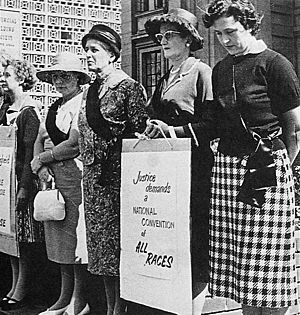Black Sash facts for kids
The Black Sash was a group of women in South Africa who worked for human rights. They started in Johannesburg in 1955. This group was made up of white women who believed in fairness and peace. They used non-violent ways to protest against unfair laws.
Contents
How the Black Sash Started
The Black Sash began on May 19, 1955. Six white women, Jean Sinclair, Ruth Foley, Elizabeth McLaren, Tertia Pybus, Jean Bosazza, and Helen Newton-Thompson, founded it. They first called themselves the Women’s Defence of the Constitution League. However, the newspapers started calling them the Black Sash. This was because the women wore black sashes during their protests. These black sashes showed they were sad about changes to South Africa's Constitution. The women met for tea in Johannesburg and decided to act against a law called the Senate Act. They organized a protest where 2,000 women marched from Joubert Park to the Johannesburg City Hall.
Fighting Against Apartheid
The Black Sash first protested against removing "Coloured" (mixed race) voters from the voting list in the Cape Province. This was done by the National Party government. As the apartheid system grew, it affected every part of life in South Africa. Apartheid was a system of laws that kept people of different races separate and treated non-white people unfairly.
Helping People with Unfair Laws
Black Sash members protested against laws like the Pass Laws. These laws made it hard for non-white people to move freely. The Black Sash later opened special offices to help non-white South Africans. These offices gave people information about their legal rights under apartheid laws. These advice offices were very important. They showed the group's brave and principled role in helping society.
Between 1955 and 1994, the Black Sash clearly showed that some white people were against apartheid. During the 1960s and most of the 1970s, the Black Sash and the National Union of South African Students were almost the only white groups consistently opposing the government outside of Parliament.
What Black Sash Members Did
- They volunteered to help families affected by apartheid laws.
- They held regular street protests.
- They spoke at political meetings.
- They told their Members of Parliament about unfair situations.
- They held peaceful protests outside Parliament and government offices.
Many members were criticized by white people in their communities. Sometimes, women wearing the black sash were even attacked by people who supported apartheid.
Important Leaders and Projects
Sheena Duncan joined the Black Sash in 1963. She led the group for many years and later became its life president. During her time, many booklets were written. These were translated into local languages to teach people their legal rights under apartheid.
In the 1980s, the Black Sash created a group called The Transvaal Rural Action Committee (TRAC). This group helped non-white communities who were forced to leave their land. In 1986, they also started and funded the Rural Women's Movement (RWM). This movement supported the rights of non-white women in rural areas, especially regarding inheritance and land ownership. TRAC hired Lydia Kompe to organize the RWM in 1986. Nomhlangano Beauty Mkhize became its first chairperson.
In 1983, the Black Sash asked for an end to military conscription. This was a law that made young white men join the army. The group helped create the End Conscription Campaign. This campaign worked against compulsory military service.
The End of Apartheid
The Black Sash's protests ended in the early 1990s. This was when apartheid ended, the ANC was allowed to operate again, and Nelson Mandela was released from prison. Nelson Mandela recognized their important work when he was released. Other political leaders also praised them.
Before the 1994 multi-racial elections, the Black Sash helped teach people how to vote. They also made a booklet called You and the Vote. In 1995, the organization changed. It became a group that works for human rights for everyone in South Africa, regardless of race.
In May 2015, the Black Sash celebrated its 60th anniversary. They now focus on education, training, and watching how communities are treated. To mark their history, two books were launched: Standing on Street Corners: a History of the Natal Midlands Region of the Black Sash and a biography by Annemarie Hendrikz.
National Presidents
- Ruth Foley 1955 - 1957
- Molley Petersen 1958 - 1959
- Eulalie Doreen Stott 1960 - 1961
- Jean Sinclair 1961 – 1975
- Sheena Duncan 1976 – 1978
- Joyce Harris 1979 - 1982
- Sheena Duncan 1983 – 1986
- Maria Macdiarmid "Mary" Burton 1987 – 1990
- Jennifer de Tolly 1991 – 1994
See also
- Feminism in South Africa
- Sandra Botha
- Sheena Duncan
- Ruth Hayman
- Mary Renault
- Noël Robb
- Helen Zille


